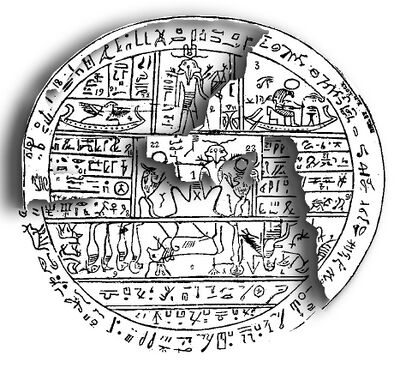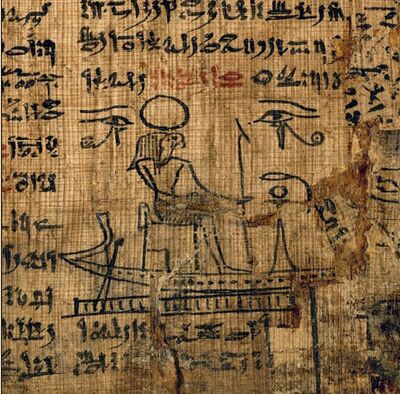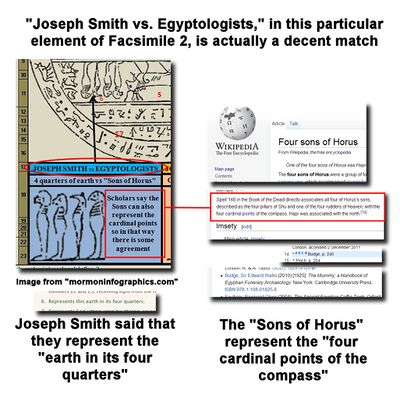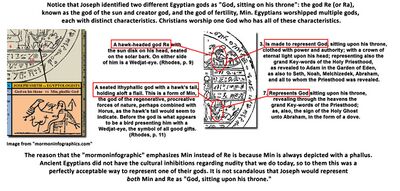
FAIR is a non-profit organization dedicated to providing well-documented answers to criticisms of the doctrine, practice, and history of The Church of Jesus Christ of Latter-day Saints.
(: m) |
|||
| Line 37: | Line 37: | ||
One critic of Mormonism states, "The following is a side-by-side comparison of what Joseph Smith translated in Facsimile #2 versus what it actually says according to Egyptologists and modern Egyptology." The letter displays a graphic from "mormoninfographics.com" called "The Book of Abraham - Hypocephalus, a funerary amulet," which compares Joseph Smith's interpretations of elements of Facsimile 2 with those provided by Egyptologists. Although this is an anti-Mormon source, the graphic acknowledges that Joseph may have gotten an element correct: "there is some agreement." | One critic of Mormonism states, "The following is a side-by-side comparison of what Joseph Smith translated in Facsimile #2 versus what it actually says according to Egyptologists and modern Egyptology." The letter displays a graphic from "mormoninfographics.com" called "The Book of Abraham - Hypocephalus, a funerary amulet," which compares Joseph Smith's interpretations of elements of Facsimile 2 with those provided by Egyptologists. Although this is an anti-Mormon source, the graphic acknowledges that Joseph may have gotten an element correct: "there is some agreement." | ||
=== | ===Joseph Smith identified the ithyphallic Egyptian god "Min" as representing "God sitting upon his throne"=== | ||
<blockquote> | |||
Question: In the Pearl of Great Price it tells us that the God is "revealing through the heavens the grand Key-words of the Priesthood." My question is, isn't that a reference to our Father in Heaven? How could | |||
it be referring to any Egyptian God sitting on his throne if he was revealing the grand Key-words of the Priesthood? | |||
</blockquote> | |||
To answer this question about Facsimile 2 figure 7, the first thing we need to disabuse is the that it constitutes "pornography" because it shows the deity with an erect phallus. A typical response to this is, "Oh, this is just dirty ancient porn that Joseph Smith was stupid enough to interpret as God." Interestingly enough, both sectarian and secular critics attack Joseph Smith on this point. However, this attitude betrays not only an immaturity about sexuality, but it also a misunderstanding of ancient Egyptian religion. The characterization of this as "pornography" is grossly inappropriate. The Egyptians would almost certainly have not conceived of this figure on the hypocephalus as "pornographic" in the way most people understand the word. This attitude reflected by some critics is a good example of how our modern, sex-crazed society can easily defile religious art. We see an erect penis and think "pornography," whereas an ancient Egyptian would have seen one and thought of fertility, virility and life. Hence the depiction of Min with an erection was a sign of his life-giving ability. We have analogies in Northwest Semitic depictions of God. (El is both called and depicted as a virile bull in the Ugaritic texts, both because of his procreative powers and his greatness over the other gods.) | |||
Another thing to keep in mind is just how common syncretism of religious ideas and iconography was between Near Eastern cultures. James White, an evangelical critic of Mormonism, objected greatly to Joseph Smith using a "pagan" phallic god to depict "the God of the Bible," but the fact is that we know ancient Hebrews and other Near Eastern people did this kind of thing all the time. The Canaanite god Baal, for example, shares the same epithet with Yahweh ("cloud rider") in Psalm 68:4. And, given our modern Mormon understanding of the nature of God, Min isn't that bad of a symbol at all for Joseph Smith to use. | |||
Hugh Nibley treated Min in his magnum opus ''One Eternal Round'', pp. 304-322. Although it is true that one of Min's attributes was that of a fertility god, or a god of procreation, he had other traits that are analogous to the attributes of both the Northwest Semitic deities of El and Baal. For one, he is often portrayed as a man sitting on a throne. Second, he is a god of Creation, the Father, Most High God, etc., as El is depicted in the Ugaritic texts, and later in the Hebrew Bible. He is also a harvest-vegetation god, and, like Baal, oversees the assurance of the renewal of animal and vegetation live through rains and floods, etc. So, like I said, to draw attention to only the fertility aspect of Min is a very myopic view. What's more, John Gee, in a very important article, has pointed out that the figure of Min is often simply called "the great god" by the Egyptians themselves. See John Gee, "Towards an Interpretation of Hypocephali," 334. | |||
Here is some further commentary on this figure by Michael Rhodes. (See attached) | |||
<blockquote> | |||
A seated ithyphallic god with a hawk's tail, holding aloft a flail. This is a form of Min, the god of the regenerative, procreative forces of nature, perhaps combined with Horus, as the hawk's tail would seem to indicate. Before the god is what appears to be a bird presenting him with a Wedjat-eye, the symbol of all good gifts. In other hypocephali it can also be an ape, a snake, or a hawk-headed snake that is presenting the eye. This figure represents Nehebka, a snake god and one of the judges of the dead in the 125th chapter of the Book of the Dead. Nehebka was considered to be a provider of life and nourishment and as such was often shown presenting a pair of jars or a Wedjat-eye. As for the bird found in Facsimile 2, this could symbolize the Ba or soul (which the Egyptians often represented as a bird) presenting the Wedjat-eye to the seated god. Joseph Smith said this figure represented God sitting upon his throne revealing the grand key-words of the priesthood. The connection of the Wedjat-eye with “the grand key-words of the priesthood” was discussed above. Joseph also explained there was a representation of the sign of the Holy Ghost in the form of a dove. The Egyptians commonly portrayed the soul or spirit as a bird, so a bird is an appropriate symbol for the Holy Ghost. Joseph Smith explained that the remaining figures contained writings that cannot be revealed to the world. Stressing the secrecy of these things is entirely in harmony with Egyptian religious documents such as the hypocephalus and the 162nd chapter of the Book of the Dead. For example, we read in the 162nd chapter of the Book of the Dead, “This is a great and secret book. Do not allow anyone's eyes to see it!” Joseph also says line 8 “is to be had in the Holy Temple of God.” Line 8 reads, “Grant that the soul of the Osiris, Shishaq, may live (eternally).” Since the designated purpose of the hypocephalus was to make the deceased divine, it is not unreasonable to see here a reference to the sacred ordinances performed in our Latter-day temples. | |||
</blockquote> | |||
{{Articles Footer 1}} {{Articles Footer 2}} {{Articles Footer 3}} {{Articles Footer 4}} {{Articles Footer 5}} {{Articles Footer 6}} {{Articles Footer 7}} {{Articles Footer 8}} {{Articles Footer 9}} {{Articles Footer 10}} | {{Articles Footer 1}} {{Articles Footer 2}} {{Articles Footer 3}} {{Articles Footer 4}} {{Articles Footer 5}} {{Articles Footer 6}} {{Articles Footer 7}} {{Articles Footer 8}} {{Articles Footer 9}} {{Articles Footer 10}} | ||
[[es:El Libro de Abraham/Papiros de José Smith/Facsímiles/Facsímil 2]] | [[es:El Libro de Abraham/Papiros de José Smith/Facsímiles/Facsímil 2]] | ||
[[fr:Book of Abraham/Joseph Smith Papyri/Facsimiles/Facsimile 2]] | [[fr:Book of Abraham/Joseph Smith Papyri/Facsimiles/Facsimile 2]] | ||




The illustration represented by Facsimile 2 (view) is a hypocephalus, a disc made of linen, papyrus, or bronze, covered with inscriptions and images which relate to one of the last spells in the Book of the Dead. The disc was placed under the head (hypocephalus = Greek: "under the head") of the deceased in the belief that the spell would cause the head and body to be enveloped in flames or radiance, making the deceased divine. Joseph Smith's notes to Facsimile 2 identify several figures as representing God sitting in the heavens among the stars and others of his creations.
Criticisms related to Facsimile 2 are related to Joseph Smith's explanations of the individual elements.
Regarding Facsimile 2, it should be noted that portions of the original Facsimile 2 appear to have been missing, and that the missing portions were filled in with characters or images taken from other sources before the image was published in the Times and Seasons. Some material was copied from the Joseph Smith papyri. Among the missing sections may have been the area identified as section #3, which matches a figure which appears on Joseph Smith Papyrus IV. One interesting thing about this restoration is that the figure in the bark boat actually does appear in this section of at least one other hypocephalus.
One critic of Mormonism states, "The following is a side-by-side comparison of what Joseph Smith translated in Facsimile #2 versus what it actually says according to Egyptologists and modern Egyptology." The letter displays a graphic from "mormoninfographics.com" called "The Book of Abraham - Hypocephalus, a funerary amulet," which compares Joseph Smith's interpretations of elements of Facsimile 2 with those provided by Egyptologists. Although this is an anti-Mormon source, the graphic acknowledges that Joseph may have gotten an element correct: "there is some agreement."
Question: In the Pearl of Great Price it tells us that the God is "revealing through the heavens the grand Key-words of the Priesthood." My question is, isn't that a reference to our Father in Heaven? How could it be referring to any Egyptian God sitting on his throne if he was revealing the grand Key-words of the Priesthood?
To answer this question about Facsimile 2 figure 7, the first thing we need to disabuse is the that it constitutes "pornography" because it shows the deity with an erect phallus. A typical response to this is, "Oh, this is just dirty ancient porn that Joseph Smith was stupid enough to interpret as God." Interestingly enough, both sectarian and secular critics attack Joseph Smith on this point. However, this attitude betrays not only an immaturity about sexuality, but it also a misunderstanding of ancient Egyptian religion. The characterization of this as "pornography" is grossly inappropriate. The Egyptians would almost certainly have not conceived of this figure on the hypocephalus as "pornographic" in the way most people understand the word. This attitude reflected by some critics is a good example of how our modern, sex-crazed society can easily defile religious art. We see an erect penis and think "pornography," whereas an ancient Egyptian would have seen one and thought of fertility, virility and life. Hence the depiction of Min with an erection was a sign of his life-giving ability. We have analogies in Northwest Semitic depictions of God. (El is both called and depicted as a virile bull in the Ugaritic texts, both because of his procreative powers and his greatness over the other gods.)
Another thing to keep in mind is just how common syncretism of religious ideas and iconography was between Near Eastern cultures. James White, an evangelical critic of Mormonism, objected greatly to Joseph Smith using a "pagan" phallic god to depict "the God of the Bible," but the fact is that we know ancient Hebrews and other Near Eastern people did this kind of thing all the time. The Canaanite god Baal, for example, shares the same epithet with Yahweh ("cloud rider") in Psalm 68:4. And, given our modern Mormon understanding of the nature of God, Min isn't that bad of a symbol at all for Joseph Smith to use.
Hugh Nibley treated Min in his magnum opus One Eternal Round, pp. 304-322. Although it is true that one of Min's attributes was that of a fertility god, or a god of procreation, he had other traits that are analogous to the attributes of both the Northwest Semitic deities of El and Baal. For one, he is often portrayed as a man sitting on a throne. Second, he is a god of Creation, the Father, Most High God, etc., as El is depicted in the Ugaritic texts, and later in the Hebrew Bible. He is also a harvest-vegetation god, and, like Baal, oversees the assurance of the renewal of animal and vegetation live through rains and floods, etc. So, like I said, to draw attention to only the fertility aspect of Min is a very myopic view. What's more, John Gee, in a very important article, has pointed out that the figure of Min is often simply called "the great god" by the Egyptians themselves. See John Gee, "Towards an Interpretation of Hypocephali," 334.
Here is some further commentary on this figure by Michael Rhodes. (See attached)
A seated ithyphallic god with a hawk's tail, holding aloft a flail. This is a form of Min, the god of the regenerative, procreative forces of nature, perhaps combined with Horus, as the hawk's tail would seem to indicate. Before the god is what appears to be a bird presenting him with a Wedjat-eye, the symbol of all good gifts. In other hypocephali it can also be an ape, a snake, or a hawk-headed snake that is presenting the eye. This figure represents Nehebka, a snake god and one of the judges of the dead in the 125th chapter of the Book of the Dead. Nehebka was considered to be a provider of life and nourishment and as such was often shown presenting a pair of jars or a Wedjat-eye. As for the bird found in Facsimile 2, this could symbolize the Ba or soul (which the Egyptians often represented as a bird) presenting the Wedjat-eye to the seated god. Joseph Smith said this figure represented God sitting upon his throne revealing the grand key-words of the priesthood. The connection of the Wedjat-eye with “the grand key-words of the priesthood” was discussed above. Joseph also explained there was a representation of the sign of the Holy Ghost in the form of a dove. The Egyptians commonly portrayed the soul or spirit as a bird, so a bird is an appropriate symbol for the Holy Ghost. Joseph Smith explained that the remaining figures contained writings that cannot be revealed to the world. Stressing the secrecy of these things is entirely in harmony with Egyptian religious documents such as the hypocephalus and the 162nd chapter of the Book of the Dead. For example, we read in the 162nd chapter of the Book of the Dead, “This is a great and secret book. Do not allow anyone's eyes to see it!” Joseph also says line 8 “is to be had in the Holy Temple of God.” Line 8 reads, “Grant that the soul of the Osiris, Shishaq, may live (eternally).” Since the designated purpose of the hypocephalus was to make the deceased divine, it is not unreasonable to see here a reference to the sacred ordinances performed in our Latter-day temples.

FAIR is a non-profit organization dedicated to providing well-documented answers to criticisms of the doctrine, practice, and history of The Church of Jesus Christ of Latter-day Saints.
We are a volunteer organization. We invite you to give back.
Donate Now